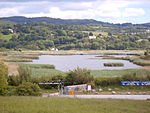Llandudno Junction railway station
DfT Category C2 stationsFormer London and North Western Railway stationsPages with no open date in Infobox stationRail junctions in WalesRailway stations in Conwy County Borough ... and 6 more
Railway stations in Great Britain closed in 1897Railway stations in Great Britain opened in 1858Railway stations in Great Britain opened in 1897Railway stations served by Avanti West CoastRailway stations served by Transport for Wales RailUse British English from January 2017

Llandudno Junction (Welsh: Cyffordd Llandudno) is a station serving the village of Llandudno Junction on the North Wales Main Line between Crewe and Holyhead. The station is managed by Transport for Wales Rail, although Avanti West Coast services also stop here. It is a junction for trains to Llandudno and the Conwy Valley line; it is one of the busiest stations in North Wales, surpassed only in passenger numbers by Llandudno, Bangor and Wrexham General.
Excerpt from the Wikipedia article Llandudno Junction railway station (License: CC BY-SA 3.0, Authors, Images).Llandudno Junction railway station
Llandudno Junction Station Footbridge,
Geographical coordinates (GPS) Address Nearby Places Show on map
Geographical coordinates (GPS)
| Latitude | Longitude |
|---|---|
| N 53.284 ° | E -3.809 ° |
Address
Llandudno Junction Station Footbridge
Llandudno Junction Station Footbridge
LL31 9NA
Wales, United Kingdom
Open on Google Maps









